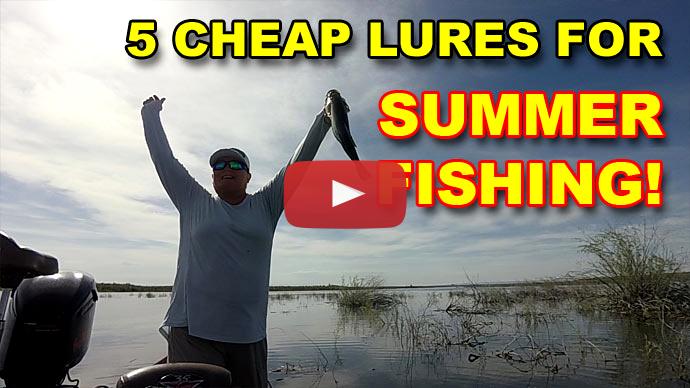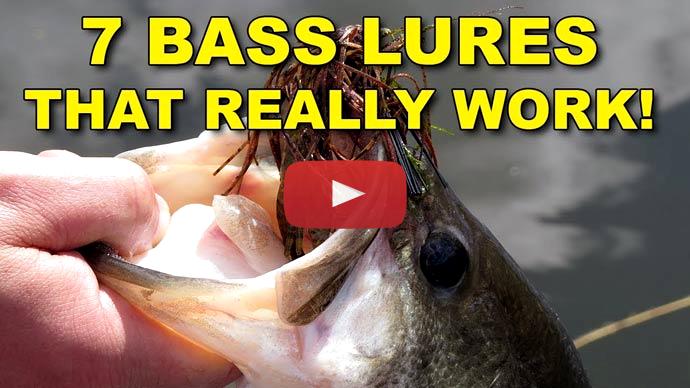You know, one of the reasons why soft plastic baits are so effective is because they're so versatile. You can rig them so many different ways that you can fish them virtually anywhere, right? All the way from super shallow to as deep as you can, in all kinds of cover, and in water clarity in different water conditions year-round, right? Part of the problem is that there's so many different ways to rig it. So let's just get down to the basics here. Here I want to talk about three of the most effective ways to rig soft plastic baits and fish them. They're also arguably the easiest. So let's start off with the drop shot rig. Now, the drop shot has been around since the '90s, and it's been a very effective way to catch fish, especially if they don't really want to bite. And it's in every bass angler's arsenal, right? It's like a go-to way of rigging your baits and catching fish when all else fails. So everybody should have a drop shot rig set up ready to go. One of the things that I hear about the most, or the questions I get the most, is leader length, like between the bait and the weight, like how long should that be? So as a general rule of thumb, I kind of split that between smallmouth and largemouth.
Smallmouth, they tend to like to bait a little bit further off the bottom than largemouth. So I'll tend to go with about a 20-inch, 24-inch leader, whereas with bass, I'll go for about a 12 to 14-inch leader. As a good starting point, it's just the smallmouth, you get that bait further up off the bottom and then give it slack and it takes longer for it to fall, they tend to hit it a lot more than if you do it with a largemouth, they want it a little bit shorter. I don't know the reasons why, I'm just saying that seems to be the case. That's kind of a general starting rule, but also I vary the weight. I typically start with an 1/8-ounce drop shot weight, but I'll go up from there as necessary. So if I'm fishing a little bit deeper or if I'm fishing a little bit bigger bait, or if I've got some windy conditions, I might go up to a 1/4-ounce, 1/3-eighth ounce, heck, I've even been known to go to a 1/2-ounce in current. So there's that, right? So just kind of vary your weight. The idea here is you just want to be able to use as light a weight as you possibly can and not have the wind, or current, or any of that carry it away. So start with that.
Also, one thing I want to dispel a quick myth here about drop shot is that a lot of people think it can only be used in clear deep reservoirs and that's not true. Drop shot is a type of rigging. So, yes, we're used to seeing finesse rods and small lines, and 6-pound line, and little bitty hooks like a swivel hook from Gamakatsu with little baits. But it can also be used in muddy water, dingy water with a little bit bigger baits. And you can even throw it in thick weeds. Here you got to heavy up using bait casting gear, braided line, and a heavier flipping style hook, but that's like a Bubba Shot, and I promise you, you get that in weeds that are like standing weeds like milfoil. You drop it down in there and just jig it, and you'll see the bass come up, and they're looking at it, and then you just pop it up and let it fall and one of them is going to commit. And then once you do, now you're in thick weeds and you've got to rip them out. So that's why you use heavier stouter equipment. But just understand you're not limited to clear water conditions, and little bitty baits, and finesse-type tactics.
Speaking of baits, again you can go the whole gambit of small baits, 3-inch baits, the normal like the 4-inch finesse worms, the grubs, the tubes, leeches. I like to use hand-poured baits a lot, so I'll use those even mini Slug-Go style baits or 3-inch Senko style hand-poured baits. I like to use those, again, on those typical traditional clear water reservoir conditions. But when I'm heavying up and I'm fishing in muddier water or I'm bubba-shotting in weeds, I'll use like a Rage Bug, or even a 6-inch finesse worm, or maybe even some other creature bait like a lizard. Let your imagination go wild and try it. You'd be surprised at how versatile and how effective the drop shot rig is in all kinds of conditions. So give it a shot. The next rig is the wacky rig. Yeah, the wacky rig, it's so simple and all you do is you just take the hook, put it right in the middle of a soft plastic stick bait and throw it out there. That's the most easiest way to fish it and you let the bait do the job. Sometimes people overwork it ,and they're wiggling the rod tip and giving pops and stuff. Sometimes the best way to fish it is just throw it out there and let it fall on its own. The bait shimmies and wiggles as it falls, and that often is the key to getting the bite, just letting it do its thing and letting it fall naturally.
But you can also do a few other things to it. You can add, like, a nail weight on one end and now you've got yourself a Neko rig. The thing about it when you do that, a lot of times it spirals on the way down. So I like to use the Neko rig hook from Gamakatsu. It's got an actual swivel on the hook and it rigs it Texas style so it's weedless. So, now, you can fish it. You don't have to worry about that hook being exposed. You can fish it in cover and the line isn't going to twist. So, now, you've added immense amount of versatility to the wacky rig just by using the Neko hook and a nail weight. But sometimes when the fish are really deep, you can use, like, a...put it on the end of a split shot or more like a drop shot, like I just mentioned, wacky rig it that way. You can get it down with the fish a little bit deeper and now you got a wacky rig bait. You've combined two, and it can be a very, very effective way of catching fish. So wacky rigs, definitely, it's got to be in your arsenal.
And, of course, you can't talk about soft plastic baits without talking about the Texas rig. That is, like, the universal way of fishing soft plastic baits. When I'm talking about the Texas rig, you got it rigged on the hook so that it is weedless, and you've got a bullet sinker up front. That to me is a Texas rig. You can fish all kinds of baits this way, but the favorite ones I like to do are the 5-and-a-1/2-inch Ribbon Tail worms, like from Big Bite Baits. I like to throw that. I like to throw lizards and Rage Tail Bugs. Those are, like, my favorites to fish Texas rig, but you can fish a bunch of other types of baits out there that you can rig and throw. The key is, like, how much weight to use. That's a question I get a lot. As a general rule of thumb, the colder the water is and/or the less active the fish are, the lighter the weight you want. In other words, you want a slower fall during those periods. But when the water is warmed up, and the fish are actively biting, that's when you want to use a little bit heavier weight for a faster fall and get them to react to it, and get them to not think much. So you don't want them to view it that long. You just want them to, as it passes by, they've got to hit it or lose it. And typically when they're really active biting, a heavier weight will elicit that bite.
Now, you can fish Texas rigs typically on inside and outside weed lines. The inside line is what's the that's the weed line that's closest to the shore. And that's usually good in the springtime when the fish are up shallow, up there feeding, ready to spawn, cruising those shallows, feeding on fish. Those inside weed lines are really good areas to fish. Whereas the rest of the year, the outside weed line is a better choice. But you can also fish them around docks, and stumps, logs, in weedy cover. It could be lily pads, reeds, even floating mats of vegetation, or submergent vegetation: hyacinths, lily pads, coontail. There's all kinds of weeds that you can fish with a Texas rig. The point is, just pick a few baits, pick a few proven baits like the Texas rig worm and lizard, just stick with those. And vary the weight a little bit. Maybe start with a 1/4-ounce weight, and then heavy up a little bit if you've got too much wind, or current, or too much cover and it's not going all the way in. Or lighten up if you have sparse cover, go to an 1/8-ounce weight to slow down that fall, and go out there and have fun. That's the thing with these three rigs. There's so many different ways you can rig a bunch of baits, but if you just stick to these three rigs, it's pretty much gonna cover every situation that you come into, and you can fish them year-round. So go out there, try them out, have a lot of fun. For more tips and tricks, like this, visit bassresource.com.



